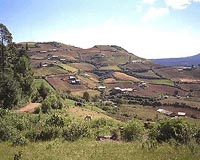 |
San Diego CA (SPX) Feb 25, 2010 Some say the world's population will swell to 9 billion people by 2030 and that will present significant challenges for agriculture to provide enough food to meet demand, says University of Idaho animal scientist Rod Hill. Hill and Larry Branen, a University of Idaho food scientist, organized a symposium during the American Association for the Advancement of Science annual meeting Sunday to explore ways biotechnology could provide healthy and plentiful animal-based foods to meet future demands. Synthetic biology, nanotechnology, genetic engineering and other applications of biotechnology - and the public's role in determining their acceptable uses - were all addressed by panelists during the session. The goal for the session, which was part of the nation's largest and most prestigious general science meeting held annually, was to encourage a dialogue among scientists and the public, said Hill, a Moscow-based molecular physiologist who studies muscle growth in cattle. "There will be a significant challenge for agriculture and the science that will be required to provide a healthy, nutritious and adequate food supply in coming decades for a rapidly growing population," Hill said. A key question, he said, is whether the Earth can continue to provide enough food without technological support. The history of civilization and agriculture during the last 10,000 years suggests otherwise. "Unaided food production is an unattainable ideal - current society is irrevocably grounded in the technological interventions underpinning the agricultural revolution that now strives to feed the world," Hill said. Branen serves as the university's Coeur d'Alene-based associate vice president for northern Idaho. He also remains active as a researcher working with nanotechnology in a variety of ways, including uses as biological sensors to detect disease or spoilage. Nanoparticles may be used to target certain genes and thus play a role in genetic engineering of food animals. Branen said, "There's also no question that nanomaterials may help increase the shelf stability of food products and assure their safety." Other panelists include University of Missouri Prof. Kevin Wells who believes genetically modified animals will have a future place on humanity's tables, just as genetically modified plants do now. Panelist Hongda Chen serves as the U.S. Department of Agriculture's national program leader for bioprocessing engineering and nanotechnology. He will explore how scientific methods like nanotechnology may be applied to help meet the world's growing demand for safe and healthy food. Synthetic biology, the use of novel methods to create genes or chromosomes, will be explored by panelist Michele Garfinkel, a policy analyst for the J. Craig Venter Institute, which pioneered the sequencing of the human genome. The public's acceptance or rejection of new technologies that could determine future food supplies will be the domain of Susanna Priest, a professor at the University of Nevada Las Vegas. A communications researcher, she has argued that public debate is essential to public attitudes toward such technologies. For Idaho's Branen, the panel provides an opportunity to advance that public discussion. "I think that's essential," he said. "We've seen lots of technologies where we didn't get adoption because we didn't get consumer acceptance and understanding. Irradiation of food has been possible for over 50 years but we still haven't gotten to general use because there is still a fear and lack of understanding of it." Branen added, "To me everything we're doing today requires an extensive discussion and an interdisciplinary approach. We can't just focus on the technology but must look at the social and political aspects of the technology as well."
Share This Article With Planet Earth
Related Links University of Idaho Farming Today - Suppliers and Technology
 A Review Of Vegetated Buffer Efficacy
A Review Of Vegetated Buffer EfficacyMadison WI (SPX) Feb 22, 2010 Environmental regulators and scientists are making concerted efforts to reduce these pollutions using mitigation tools called best management practices (BMPs). As promising and effective BMPs, vegetated buffers are gradually gaining in popularity. However, lack of quantification on their mitigation efficacies limits their implementation in agricultural fields to reduce nonpoint source pollutions ... read more |
|
| The content herein, unless otherwise known to be public domain, are Copyright 1995-2010 - SpaceDaily. AFP and UPI Wire Stories are copyright Agence France-Presse and United Press International. ESA Portal Reports are copyright European Space Agency. All NASA sourced material is public domain. Additional copyrights may apply in whole or part to other bona fide parties. Advertising does not imply endorsement,agreement or approval of any opinions, statements or information provided by SpaceDaily on any Web page published or hosted by SpaceDaily. Privacy Statement |